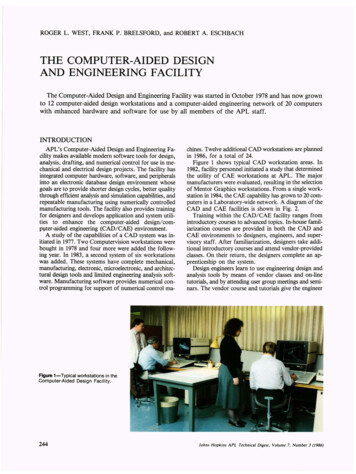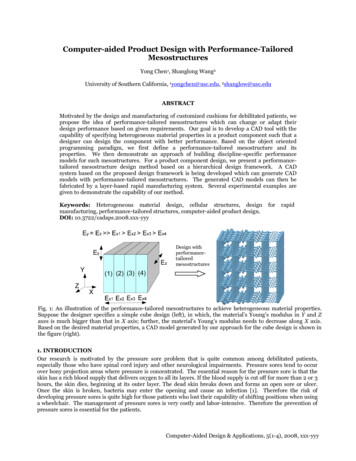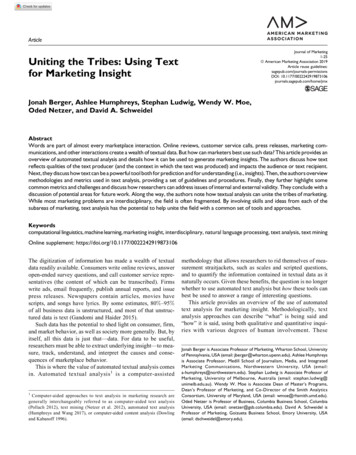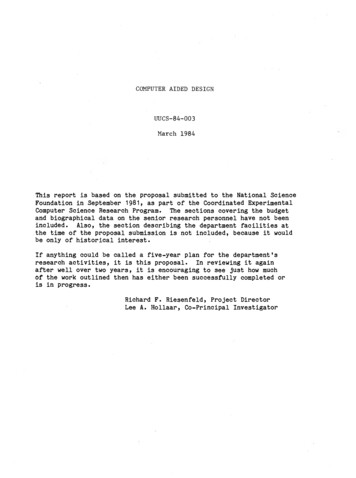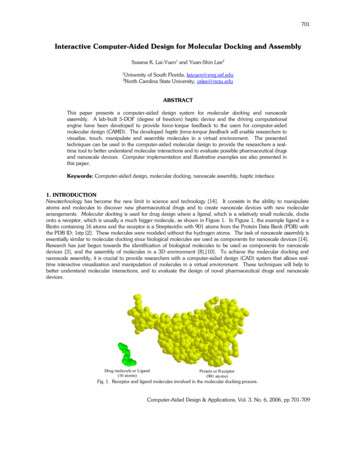
Transcription
701Interactive Computer-Aided Design for Molecular Docking and AssemblySusana K. Lai-Yuen1 and Yuan-Shin Lee21University of South Florida, laiyuen@eng.usf.eduNorth Carolina State University, yslee@ncsu.edu2ABSTRACTThis paper presents a computer-aided design system for molecular docking and nanoscaleassembly. A lab-built 5-DOF (degree of freedom) haptic device and the driving computationalengine have been developed to provide force-torque feedback to the users for computer-aidedmolecular design (CAMD). The developed haptic force-torque feedback will enable researchers tovisualize, touch, manipulate and assemble molecules in a virtual environment. The presentedtechniques can be used in the computer-aided molecular design to provide the researchers a realtime tool to better understand molecular interactions and to evaluate possible pharmaceutical drugsand nanoscale devices. Computer implementation and illustrative examples are also presented inthis paper.Keywords: Computer-aided design, molecular docking, nanoscale assembly, haptic interface.1. INTRODUCTIONNanotechnology has become the new limit in science and technology [14]. It consists in the ability to manipulateatoms and molecules to discover new pharmaceutical drugs and to create nanoscale devices with new moleculararrangements. Molecular docking is used for drug design where a ligand, which is a relatively small molecule, docksonto a receptor, which is usually a much bigger molecule, as shown in Figure 1. In Figure 1, the example ligand is aBiotin containing 16 atoms and the receptor is a Streptavidin with 901 atoms from the Protein Data Bank (PDB) withthe PDB ID: 1stp [2]. These molecules were modeled without the hydrogen atoms. The task of nanoscale assembly isessentially similar to molecular docking since biological molecules are used as components for nanoscale devices [14].Research has just begun towards the identification of biological molecules to be used as components for nanoscaledevices [3], and the assembly of molecules in a 3D environment [8],[10]. To achieve the molecular docking andnanoscale assembly, it is crucial to provide researchers with a computer-aided design (CAD) system that allows realtime interactive visualization and manipulation of molecules in a virtual environment. These techniques will help tobetter understand molecular interactions, and to evaluate the design of novel pharmaceutical drugs and nanoscaledevices.Drug molecule or LigandProtein or Receptor(16 atoms)(901 atoms)Fig. 1. Receptor and ligand molecules involved in the molecular docking process.Computer-Aided Design & Applications, Vol. 3, No. 6, 2006, pp 701-709
702Computer-aided techniques for molecular docking have recently received a lot of attention due to its importance in themedicine and drug design industry while molecular device design is still in its infancy. In recent years, besides usingthe visualization techniques, there has been increasing interest in using the haptic interface to facilitate the explorationand analysis of molecular docking and assembly [10, 12]. A haptic device is an electromechanical device that exertsforces on users giving them the illusion of touching something in the virtual world, as shown in Figure 2.Fig. 2. Haptic device and interface [7].In our previous work, a haptic-based force-torque feedback system has been developed for product development andmanufacturing [13]. To provide the user with realistic sensation of touch through the haptic device, the computationshould achieve an update rate of 1 kHz. Previous methods using the haptic interface for molecular docking andassembly modeled the ligand as a rigid body during the analysis and simulation [1],[10],[12]. However, molecules arevery “flexible” in adopting different molecular conformations (or shapes) by changing their internal torsional bonds.Therefore, handling molecular flexibility and searching for new and feasible molecular conformations have beenidentified as computationally expensive and as major challenges in molecular design [9]. Moreover, given the hapticdevice update rate requirement of 1 kHz, the task of handling molecular flexibility in real-time becomes an extremelycomplex problem.This paper presents a new method for finding molecular conformations in real-time for molecular docking andassembly. The proposed method will provide researchers with an approximation of the molecule’s behavior asmolecules are virtually assembled facilitating the identification of pharmaceutical drugs and the design of nanoscaledevices.2. OVERVIEW OF THE PROPOSED MOLECULAR CAD SYSTEM WITH HAPTIC INTERFACEFigure 3 shows the general concept of the proposed computer-aided design for molecular docking and assembly withhaptic interface. The lab-built 5-DOF haptic device, the haptic hardware controller and the haptic rendering softwarewere developed for educational purposes. The haptic interface device can detect 6-DOF of haptic probe movementand provide 5-DOF feedback, with both force and torque feedback.As shown in Figure 3, the user can manipulate a ligand around the receptor to understand and to study theintermolecular interactions using the developed haptic interface. The user can feel the intermolecular force and torquethrough the haptic device. In our previous work [4, 7], a nano-scale docking and assembly simulator (NanoDAS) wasdeveloped to determine the feasibility in terms of energy and geometry of a ligand to dock or assemble into thereceptor. The NanoDAS constructs a search tree starting from the user-specified location to explore the search spaceand to exploit the low-energy regions. Therefore, as the user manipulates the ligand and feels the intermolecular forcesthrough the haptic device, NanoDAS can help the user in identifying whether a ligand can be docked or assembledinto a receptor.Computer-Aided Design & Applications, Vol. 3, No. 6, 2006, pp 701-709
703Molec rquefeedbackLigandHaptic user interfaceStep 3Feasibility analysisresults for candidatemoleculeStep 1Apply methodReceptorLigand PathsStep 2FeasibilityanalysisAutomatic MolecularDocking and AssemblySearch Method Search Engine3D Gridenergyand force*NanoDAS: Nano-scale Docking and Assembly SimulatorFig. 3. The proposed haptic-based computer-aided design for molecular docking and assembly.3. CALCULATION OF POTENTIAL ENERGY AND MOLECULAR INTERACTION FORCE-TORQUEInteractions between molecules are represented by the potential energy created between them. Although both receptorand ligand molecules are flexible bodies, it is commonly assumed that the receptor is a rigid-body while the ligand is aflexible-body [1]. The potential energy function used in this work is approximated by the van der Waals terms and isexpressed as follows:N lig N recE AijBij rij12 rij6 i 1 j 1 (1) Where Nlig and Nrec are the number of atoms in the ligand and the receptor, respectively, Aij and Bij are the van derWaals repulsion and attraction parameters, and rij is the distance between the centers of atoms i and j. The van derWaals parameters for a single atom type are calculated based on the atom’s van der Waals radius and well depth [11].Given the haptic update requirement of 1 kHz, a 3D grid method is used to calculate the potential energy and force inreal-time [1, 10]. The receptor is enclosed by the 3D grid where each grid point stores the potential energy generatedby surrounding receptor atoms at that point. A second 3D grid is used to pre-compute the list of possible collidingreceptor atoms to speed up collision detection [10]. Each collision grid stores the possible receptor colliding atoms,Computer-Aided Design & Applications, Vol. 3, No. 6, 2006, pp 701-709
704assuming a ligand atom is placed in the collision grid cell. When a ligand is introduced in the vicinity of the receptor,all the grids occupied by the ligand atoms are used in calculating the total interaction energy and force between theligand and the receptor. A 0.5 Å size grid was used in this work since it was shown to provide an accurate enoughapproximation [1].The total molecular interaction force Ftotal acting on the ligand by the receptor can be found by summarizing twoforces [5, 6]: the molecular potential force Fpotential , and the collision forceFtotal F potential FcollisiondE drijFcollision shown as follows:ncollision δ k ( piwall pi )(2)i 1Where rij is the distance between a ligand atom i and a receptor atom j, ncollision is the number of ligand atoms incollision with receptor atoms, δ is the Kronecker delta, and δ 1 if the ligand pi falls inside any of the collision gridsand δ 0 otherwise, pi is the center of the ligand atom i in collision, piwall is the projection of pi onto the virtual wallof the collision receptor, and k is a pre-defined spring constant of molecules.Once the molecular interaction force Ftotal is found by Equation (2), the haptic total torque τ is calculated based on a pivot point Ppvt defined as the ‘center of weight’ of a ligand. The accumulated force is assumed to be applied throughthe pivot point of the molecule. Therefore, the total torque τ induced at the pivot point Ppvt by a collision point Pi iscalculated as follows: τ N lig N rec i 1 j 1 Ppvt Pi Fij (3)Where Ppvt is the virtual pivot point’s location, Pi is the collision point’s location, and Fij is the corresponding collisionforce between a ligand atom i and a receptor atom j. The following sections present the haptic force-torque renderingfor finding flexible molecular conformations in real-time.4. HAPTIC INTERFACE FOR REAL-TIME FLEXIBLE LIGAND CONFORMATIONAL SEARCHAs the user manipulates the ligand to experience the molecular interactions with the receptor, the ligand needs tochange its geometric shape based on the forces acting on the ligand by the receptor. Anytime the ligand is subject tohigh forces (or high potential energies), the ligand tends to change its geometric shape or molecular conformation to amore stable conformation as shown in Figure 4. A stable molecular conformation is represented by a molecularconformation that minimizes the potential energy E described in Equation (1). As shown in Figure 4(a), a moleculecan be modeled as an articulated body where an arbitrarily-selected atom acts as the base of the body. A flexible bodyhas at least six degrees of freedom (dof): three translational and three rotational. In addition, each torsional bond ofthe molecule accounts for an additional degree of freedom, as shown in Figure 4(a). In a molecule, changes in itstorsional angles cause the greatest geometric changes compared to changes in the molecule’s bond lengths and bondangles. For this reason, it is normally assumed that a molecule’s bond lengths and bond angles are fixed during thesearch for a feasible molecular conformation. Therefore, the conformation of a molecule can be defined as thechanges in the angles of the torsional bonds.Since haptic applications require an update rate of 1 kHz, the computation burden of finding the accurate ligandconformation in real-time becomes infeasible [16]. For this reason, the objective of a quick conformational search is tofind a ligand conformation that approximately represents the behavior of a ligand as it approaches the receptor. Figure4(a) shows a molecule where the atoms are clustered into AtomClusters according to the type of bonds in betweenthem [15]. This method creates some local frames to each AtomCluster so the update of atom positions as thetorsional bond rotates requires less computation time and decreases inaccuracies in calculations.Computer-Aided Design & Applications, Vol. 3, No. 6, 2006, pp 701-709
705AtomCluster 1Rotatedtorsional bondTorsional bondsφ1φ1φ2φ3RootAtomClusterReceptorφ2, new φ3LigandAtomCluster 3AtomCluster 2LigandReceptor(a) Molecules in collision(b) Molecular configuration changeFig. 4. Molecular conformation change through energy minimization using the adaptive local search method.To provide the user with real-time ligand molecular flexibility, an adaptive local search is proposed in this paper.Figure 4 shows the process of searching for a new molecular conformation as the ligand collides with the receptor(potential energy increases). When the ligand is determined to be in collision with the receptor as in Figure 4(a), theadaptive local search method is executed to find a set of new torsional angles that result in a new collision-free andlow-energy molecular conformation, as shown in Figure 4(b). If no feasible collision-free new molecular conformationcan be found after searching, the adaptive local search method returns the original molecular conformation. Thefollowing algorithm presents the proposed adaptive local search technique for finding a new collision-free molecularconformation with lower potential energy:Algorithm. Adaptive Local Search and Energy Minimization for Molecular Docking.Inputs:qcur: Current molecular conformation.Outputs: qnew: New molecular conformation,Enew : Energy for new molecular conformation qnew if exists,Fnew: Haptic force feedback of qnew,τ new : Haptic torque feedback of qnew.Step 1. Initialize the new conformation qnew qcur;Initialize ligand collision 0.Step 2. Calculate the new molecular energy E new of qnew by Equation (1).Step 3. Calculate the new molecular interactive force Fnew and the new torque τ new of the new conformation qnewusing Equations (2) and (3).Step 4. Check if any ligand atom of qnew occupies any of the collision grids.If so, set ligand collision 1.Step 5. IF (ligand collision 0), thenGo to Step 7;ELSE Set the number of iterations g 0.Step 6. WHILE (g gmax)qtest NEW TORSION ANGLES();Set Etest 0; Ftest 0; τ test 0;FOR (each AtomCluster ACk in qtest)collision CHECK COLLISION(ACk);IF (collision 1), Then Exit FOR-Loop;ELSE, Assign E AC k , FAC k ,τ AC k GET ENERGY FORCE TORQUE(ACk);Computer-Aided Design & Applications, Vol. 3, No. 6, 2006, pp 701-709
706()()()Etest Etest E AC k ; Ftest Ftest FAC k ; τ test τ test τ AC k .END-FOR.IF [(collision 0) AND (Etest Enew)]Enew Etest; Fnew Ftest ; τ new τ test ;qnew qtest; g gmax.END-IF.g g 1.END-WHILE.Step 7. Output (qnew, Enew, Fnew , τ new ).END.In the algorithm, the function NEW TORSION ANGLES() assigns new torsional angles to the ligand within the bonds’allowable torsional angles range for the new test molecular conformation qtest . The function CHECK COLLISION()checks each AtomCluster in the test conformation qtest for possible collision with the receptor.The functionGET ENERGY FORCE TORQUE() calculates the new energy, interactive force and torque for the new qtest . If thetest conformation qtest is collision-free and its energy Etest is below the current conformation’s energy Enew , the newtest conformation qtest is accepted to replace qnew . More details of the method can be found in [6].5. COMPUTER IMPLEMENTATIONS AND EXAMPLESThe proposed adaptive searching techniques with the haptic force-torque rendering have been implemented on a dual2.4 GHz CPU workstation using Visual C programming language and OpenGL library functions. The ligands andproteins used in the examples are from the public domain Protein Data Bank (PDB) [2]. Figure 5(a) shows the lab setup of the haptic device and computer display implemented at our research lab. Figure 5(b) shows the haptic userinterface with an example receptor Tyrosyl-tRNA synthetase and a ligand Tyrosine (PDB ID: 4ts1). The Tyrosyl-tRNAsynthetase receptor has 2,423 atoms and the Tyrosine ligand has 13 atoms, as shown in Figure 5(b).Receptor2,423 atomsLigand13 atoms, 9 DOFs(a) Haptic display and device developed at our research lab(b) Developed haptic interface for molecular dockingand assemblyFig. 5. Haptic graphical interface and the example receptor-ligand complex.Figure 6 shows the behavior of the ligand as it approaches the example receptor. It can be observed in Figures 6(a)and (b) that the ligand contacts the receptor during docking/assembly and the interaction force is observed. Thedeveloped local search algorithm is invoked to find a new feasible conformation of the ligand. Figure 6(c) shows thenew conformation of the ligand and the reduced interaction force. As the ligand continues to approach the receptor,Computer-Aided Design & Applications, Vol. 3, No. 6, 2006, pp 701-709
707the energy and force increase again as shown in Figure 6(d). Figure 6(e) shows the change of the total potentialenergy between the ligand and the receptor at different locations. Notice the high energy level at the position b wherethe collision occurs and the lower energy level at the position c after it changes to a new flexible conformation, asshown in Figure 6(e). Figure 6(f) shows the interaction force response at different locations as the ligand approachesthe receptor using the proposed adaptive local search method is applied.ForceCollisionLigandReceptor(b) Position b(a) Position aForceTorqueConformationchange(d) Position d(c) Position cForce magnitude responsePotential energy betw een ligand and receptorForcePosi tion bPotentialenergy 105(kJ/mol)Position b(kJ/mol/Å)Position d80150Position dPosition c5530100Position aPosition c505Position aPosition0- 20(e) Potential energy at different ligand positionsPosition(f) Force response at different ligand positionsFig. 6. Results of the proposed adaptive local search algorithm for real-time flexible ligand conformational search.Figure 7 shows the difference between docking/assembling a rigid and a flexible Tyrosine ligand into the Tyrosyl-tRNAsynthetase receptor. When a rigid ligand is used, it is observed that a collision exists and the ligand encounters highrepulsive forces as shown in Figure 7(a). On the other hand, when a flexible ligand (9 DOFs) is found by thedeveloped searching algorithm, the ligand changes its flexible conformation and an attractive force towards thereceptor is created as shown in Figure 7(b). The attractive force generated by the ligand’s new conformation makesthe docking/assembly to the receptor possible. Figure 7(c) shows the ligand docked/assemble to the receptor.Figure 7(d) shows the different force responses of using the rigid ligand and the flexible ligand. As shown in Figure7(d), the flexible ligand changes into a new conformation with significantly less resistant force and successfullydocks/assembles into the receptor. Through the interactive haptic system, the user experiences the change ofmolecular responding forces and torques from repulsive to attractive while performing the design and simulation ofmolecular docking and assembly.Computer-Aided Design & Applications, Vol. 3, No. 6, 2006, pp 701-709
708Flexible ligandRigid ligandLigand changingconformationHigh repulsiveforceReceptorLigandReceptor(a) Rigid ligand encounters high repulsive forcesand stops at the narrow passage near the receptor(b) Flexible ligand changing to a new conformationcreating attractive forces towards the receptorForce magnitude for docking the rigid and flexible ligandskJ/mo l/ A150Ligand docked atthe receptorRigid ligandFlexible ligand100Receptor500Rig id ligand(c) Flexible ligand successfully docked intothe receptorFlexib le ligandPosition(d) Force magnitude for docking the rigidand flexible ligandsFig. 7. Results for docking/assembling rigid and flexible ligands to a receptor.6. CONCLUSIONSIn this paper, a new method of computer-aided molecular design (CAMD) with the haptic force-torque rendering hasbeen presented. An adaptive local search and energy minimization method has been developed for molecular dockingand assembly. The molecular flexibility in terms of its torsional angles is considered to find new collision-free and lowenergy molecular conformations that will facilitate the docking and assembly of molecules. The presented techniquescan be used for the computer-aided molecular design (CAMD) to provide researchers a real-time interactive computeraided design for the visualization, manipulation and assembly of molecules in a virtual environment.7. ACKNOWLEDGMENTSThis work was partially supported by the National Science Foundation (NSF) Grant (DMI-0300297) and the ArmyResearch Office (Grant #W911NF-04-D-0003) to North Carolina State University. Their support is greatlyappreciated. The author would also like to thank Dr. Donald Brenner of the Materials Science and EngineeringDepartment at NCSU and Dr. Sanjay Sarma of Mechanical Engineering Department at MIT for their helpful discussionand suggestions.8. REFERENCES[1]Bayazit, O. B., Song, G., and Amato, N. M., Ligand binding with OBPRM and user input, Proceedings of theIEEE International Conference on Robotics & Automation, Seoul, Korea, May 21-26, 2001, pp 954-959.[2]Berman, H. M., Westbrook, J., Feng, Z., Gilliland, G., Bhat, T. N., Weissig, H., Shindyalov, I. N. and Bourne,P. E., The Protein Data Bank, Nucleic Acids Research, Vol. 28, 2000, pp 235-242.[3]Dubey, A., Sharma, G., Mavroidis, C., Tomassone, S. M., Nikitczuk, K., and Yarmush, M. L., Dynamics andkinematics of viral protein linear nano-actuators for bio-nano robotic systems, Proceedings of the IEEEInternational Conference of Robotics and Automation, New Orleans, LA, April 26-May 1, 2004, pp 1628-1633.[4]Lai-Yuen, S. K., and Lee, Y.-S., NanoDAS: A nano-scale docking and assembly simulator for computer-aidedmolecular design (CAMD), (in revision), Submitted to Computer-Aided Design, 2004.Computer-Aided Design & Applications, Vol. 3, No. 6, 2006, pp 701-709
Yuen, S. K., and Lee, Y.-S., Computer-aided molecular design (CAMD) with force-torque feedback,Proceedings of the Ninth International Conference on Computer Aided Design and Computer Graphics, HongKong, China, December 7-10, 2005, pp. 199-204.Lai-Yuen, S. K., Lee, Y.-S., and Zhu, W., Haptic force-torque rendering and energy minimization for computeraided molecular design (CAMD) and assembly simulation, (in revision) Submitted to the Computer-AidedDesign, 2005.Lai-Yuen, S. K., and Lee, Y.-S., Haptic-based automatic molecular docking and assembly search system forcomputer-aided molecular design (CAMD), To appear in Proceedings of the IEEE Virtual Reality Conference,Alexandria, VA, March 25-29, 2006.Lai-Yuen, S. K., and Lee, Y.-S., Computer-aided design and simulation for nano-scale assembly, To appear inthe Transactions of the North American Manufacturing Research Conference (NAMRC), Milwaukee, WI, May23-26, 2006.LaValle, S. M., Finn, P. W., Kavraki, L. E., and Latombe, J.-C., A randomized kinematics-based approach topharmacophore-constrained conformational search and database screening, Journal of ComputationalChemistry, Vol. 21, No. 9, 2000, pp 731-747.Lee, Y.-G., and Lyons, K. W., Smoothing haptic interaction using molecular force calculations, Computer-AidedDesign, Vol. 36, No. 1, 2004, pp 75-90.Meng, E. C., Shoichet, B. K., and Kuntz, I. D., Automated docking with grid-based energy evaluation, Journalof Computational Chemistry, 13(4), 1992, pp. 505-524.Nagata, H., Mizushima, H., and Tanaka, H., Concept and prototype of protein-ligand docking simulator withforce feedback technology, Bioinformatics, Vol. 18, No. 1, 2002, pp 140-146.Ren, Y., Lai-Yuen, S. K., and Lee, Y.-S., Virtual prototyping and manufacturing planning by using tri-dexelmodels and haptic force feedback, Virtual and Physical Prototyping, Vol. 1, No. 1, pp 3-18.Sharma, G., Mavroidis, C. and Ferreira, A., Virtual reality and haptics in nano- and bionanotechnology,Handbook of Theoretical and Computational Nanotechnology, Edited by M. Rieth and W. Schommers,American Scientific Publishers, 2005.Zhang, M., and Kavraki, L. E., A new method for fast and accurate derivation of molecular conformations,Journal of Chemical Information and Computing Sciences, Vol. 42, 2002, pp 64-70.Zhu, W., and Lee, Y-S., A visibility sphere marching algorithm of constructing polyhedral models for hapticsculpting and product prototyping,” Robotics and Computer Integrated Manufacturing, Vol. 21, No. 1, 2005,pp. 19-36.Computer-Aided Design & Applications, Vol. 3, No. 6, 2006, pp 701-709
Computer-Aided Design & Applications, Vol. 3, No. 6, 2006, pp 701-709 702 Computer-aided techniques for molecular docking have recently received a lot of attention due to its importance in the medicine and drug design industry while molecular device design
